Catalytic cracking of paraffin:
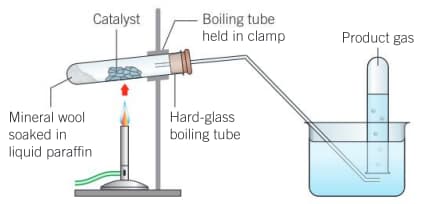
Procedure:
A mineral wool to a depth of in the bottom of the boiling tube. of liquid paraffin is dropped onto it using a dropping pipette. The boiling tube are clamped as shown in the diagram. 2–3 spatulas of the catalyst is placed in the centre of the tube and connect the tube. Six test tubes are filled with water and kept inverted in the water trough. The catalyst in the middle of the tube is strongly heated for a few minutes. When the catalyst is hot, the flame is passed back and forth over the liquid paraffin and catalyst to vaporize some of the liquid paraffin. Once the gas is released, the contents of the boiling tube is continuously heated to avoid suck-back. When a steady stream of gas bubbles are established, the six test tubes of gas are collected and sealed each full test tube with a bung. The first two test tubes are kept separate from the others. When gas collection is complete, the delivery tube is removed from the water by tilting or lifting the clamp stand, and then heating is stopped.
Question: Explain why the first two test tubes are discarded, and what is the main component in these samples?


Important Questions on Evidence
Catalytic cracking of paraffin:
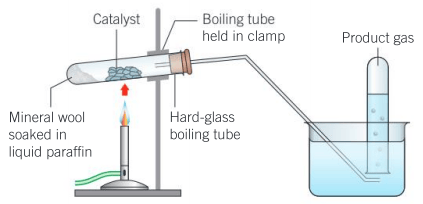
Procedure:
A mineral wool to a depth of in the bottom of the boiling tube. of liquid paraffin is dropped onto it using a dropping pipette. The boiling tube are clamped as shown in the diagram. spatulas of the catalyst is placed in the centre of the tube and connect the tube. Six test tubes are filled with water and kept inverted in the water trough. The catalyst in the middle of the tube is strongly heated for a few minutes. When the catalyst is hot, the flame is passed back and forth over the liquid paraffin and catalyst to vaporize some of the liquid paraffin. Once the gas is released, the contents of the boiling tube is continuously heated to avoid suck-back. When a steady stream of gas bubbles are established, the six test tubes of gas are collected and sealed each full test tube with a bung. The first two test tubes are kept separate from the others. When gas collection is complete, the delivery tube is removed from the water by tilting or lifting the clamp stand, and then heating is stopped.
Question: Describe the colour changes observed in the tests performed on the final two test tubes by using bromine water and potassium permanganate respectively.
Catalytic cracking of paraffin:
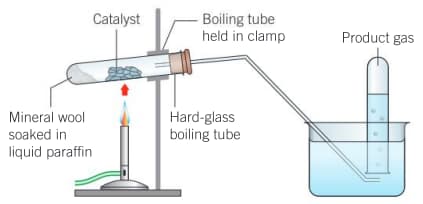
Procedure:
A mineral wool to a depth of in the bottom of the boiling tube. of liquid paraffin is dropped onto it using a dropping pipette. The boiling tube are clamped as shown in the diagram. 2–3 spatulas of the catalyst is placed in the centre of the tube and connect the tube. Six test tubes are filled with water and kept inverted in the water trough. The catalyst in the middle of the tube is strongly heated for a few minutes. When the catalyst is hot, the flame is passed back and forth over the liquid paraffin and catalyst to vaporize some of the liquid paraffin. Once the gas is released, the contents of the boiling tube is continuously heated to avoid suck-back. When a steady stream of gas bubbles are established, the six test tubes of gas are collected and sealed each full test tube with a bung. The first two test tubes are kept separate from the others. When gas collection is complete, the delivery tube is removed from the water by tilting or lifting the clamp stand, and then heating is stopped.
Question: Predict the outcome of both of tests done on the first two test tubes that were discarded by using bromine water and potassium permanganate respectively. Explain your reasoning.
Data-based question: Ethanol and biofuels
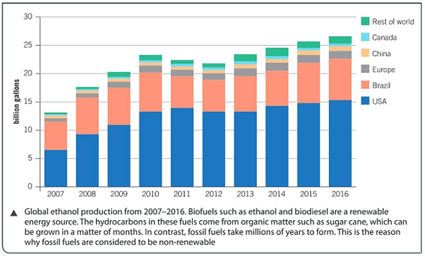
Identify the largest producer of ethanol and suggest possible reasons for this.
Data-based question: Ethanol and biofuels

Discuss why the level of production of ethanol has increased from to .
Data-based question: Ethanol and biofuels
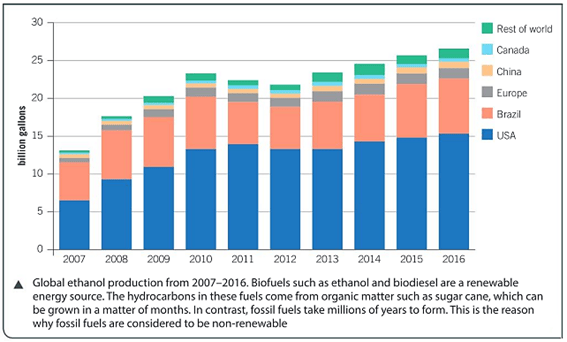
China has a large population in global terms and a very large manufacturing sector, but its ethanol production is among the lowest of the nations listed. Why might that be the case? Do you think that this might change in the near future, and if so why.
Data-based question: Ethanol and biofuels
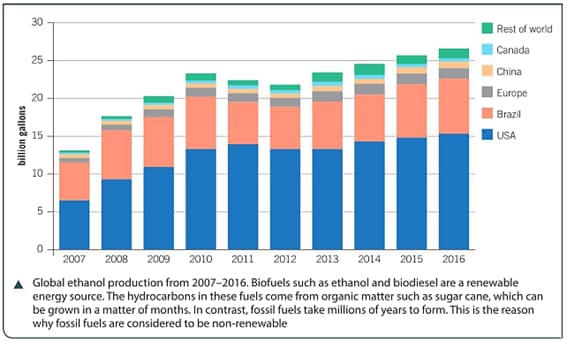
What natural resources might explain Brazil’s high ethanol production?
The text below is part of an online article from the US Department of Energy from October . Note the following details before you read the article.
- is a blend of gasoline and ethanol which contains up to ethanol.
- A US gallon is an imperial unit of measurement of volume. It is the equivalent of litres.
- A US ton is an imperial unit of measurement of mass. It is the equivalent of .
California ramps up biofuels infrastructure
New renewable diesel, biodiesel, and fuelling pumps are cropping up across California as Clean Cities stakeholders work to expand the availability of biofuels.
station. As of , it boasts more than public stations, due in large part to a station-development project known as the Low Carbon Fuel Infrastructure Investment Initiative (LCF). The project has the potential to displace million gallons of petroleum and tons of carbon dioxide emissions per year.
In addition, the project has created more than green jobs in a state particularly hard-hit by unemployment. LCF is funded through an American Recovery and Reinvestment Act award and by the California Energy Commission and Propel Fuels. California has more than million diesel and flexible fuel vehicles on the road, and LCF is now matching the fuels to the vehicles
East Bay Clean Cities and other California coalitions are working with project partners, like Propel Fuels and the California Department of General Service, to target ZIP codes with high densities of alternative fuel vehicles and to find locations where the coalitions’ fleet partners operate. Clean Cities coalitions are also coordinating with station owners to publicize the new facilities, through station opening events, ethanol buy-down days, and identification and outreach to potential fleet customers for the new fuelling facilities.
Biofuels providers and Clean Cities coalitions began laying the foundation for the new fuelling infrastructure back in by contacting elected officials, educating local regulatory agencies, and helping to streamline permitting processes. Today, fuel providers are able to offer station owners turn-key packages, complete with tanks and dispensers, with a minimum of paperwork. And with more stations coming online every month, California is poised to be a global leader in the deployment of low-carbon, alternative fuels.
- Summarise this article for an international audience in not more than words.
The text below is part of an online article from the US Department of Energy from October . Note the following details before you read the article.
- is a blend of gasoline and ethanol which contains up to ethanol.
- A US gallon is an imperial unit of measurement of volume. It is the equivalent of litres.
- A US ton is an imperial unit of measurement of mass. It is the equivalent of .
California ramps up biofuels infrastructure
New renewable diesel, biodiesel, and fuelling pumps are cropping up across California as Clean Cities stakeholders work to expand the availability of biofuels.
station. As of , it boasts more than public stations, due in large part to a station-development project known as the Low Carbon Fuel Infrastructure Investment Initiative (LCF). The project has the potential to displace million gallons of petroleum and tons of carbon dioxide emissions per year.
In addition, the project has created more than green jobs in a state particularly hard-hit by unemployment. LCF is funded through an American Recovery and Reinvestment Act award and by the California Energy Commission and Propel Fuels. California has more than million diesel and flexible fuel vehicles on the road, and LCF is now matching the fuels to the vehicles
East Bay Clean Cities and other California coalitions are working with project partners, like Propel Fuels and the California Department of General Service, to target ZIP codes with high densities of alternative fuel vehicles and to find locations where the coalitions’ fleet partners operate. Clean Cities coalitions are also coordinating with station owners to publicize the new facilities, through station opening events, ethanol buy-down days, and identification and outreach to potential fleet customers for the new fuelling facilities.
Biofuels providers and Clean Cities coalitions began laying the foundation for the new fuelling infrastructure back in by contacting elected officials, educating local regulatory agencies, and helping to streamline permitting processes. Today, fuel providers are able to offer station owners turn-key packages, complete with tanks and dispensers, with a minimum of paperwork. And with more stations coming online every month, California is poised to be a global leader in the deployment of low-carbon, alternative fuels.
- What benefits has LCF brought to California?
